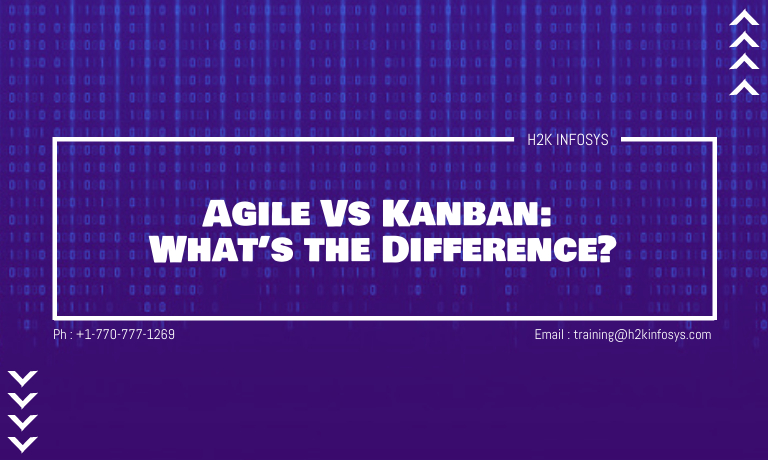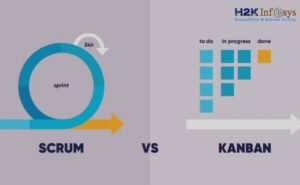We will explore the main differences between Agile and Kanban in this article on Agile vs Kanban. But before we get into Agile vs Kanban, let’s take a look at both of them separately.
What basically is Agile?
Agile methodology is a growth and monitoring process that is iterated continuously throughout the SDLC life cycle. Agile is a method of development that differs from a waterfall or conventional sequential development. It’s an excellent method for those who like to work with continuous feedback.
It’s a dynamic mechanism in which requirements alter and evolve. Each iteration’s primary goal is to provide a functioning product.
Teamwork and direct collaboration are encouraged in an Agile approach by the leadership. Stakeholders and developers should collaborate to align the product to the customer’s needs and the company’s objectives.
What is the Kanban method?
The Kanban method is nothing but a board called a “Kanban Board.” This board is very important for presenting the job workflow. It aids in the optimization of work movement between various teams. It’s a method of identifying, handling and improving services for delivering quality work.
Work items are printed visually in this method. It enables team members to see the current status of each piece of work at each stage of development. Furthermore, a team member has a better understanding of who is doing what and can recognize and minimize problem areas in the process.
The Kanban approach helps you to reprioritize work based on the needs of your stakeholders. As work progresses from one condition to the next, further work is applied until the flow is stable. The team works together to maximize the efficiency of the project’s workflow. Kanban is never limited to a fixed method or specified sprint backlog in an Agile process. As a result, it gives developers a lot of options.
Now, we will discuss the major differences between Agile and Kanban.

Major Differences
- Agile is a helpful approach for projects where the end target is not set, whereas Kanban is useful for waste reduction and the elimination of tasks that do not bring value to the team.
- Agile processes promote continuous coordination, while Kanban processes require items to be broken up to fit inside sprint boundaries due to shorter sprint lengths.
- Agile does not support visual verification of work in progress, whereas Kanban does.
- Continuous integration, development, and testing are the goals of the Agile approach, while the purpose of the Kanban approach is to enhance the team’s process.
- Storyboards are used in the Agile process, while Kanban Boards are used in the Kanban process.
Principles of Agile
- The aim is to please the user by providing a continual improvement in the delivery of software.
- It is still open to improvement, even at later stages.
- It provides a working system in 15 days to one month, to keep the timeframe as short as possible.
- Business partners and the development team will work on the project daily before it is completed.
- In the Agile Process, functioning software is essential.
- An agile software development strategy encourages long-term growth.
- It pays close attention to technological knowledge.
Principles of Kanban
- The Kanban method visualizes the workflow and makes it simple to comprehend.
- It encourages leadership at all levels.
- It aids in the monitoring and evaluation of collaboration.
- It supports the current process, tasks, and responsibilities.
- It assists the team in making the process simple and clear.
Important differences between Agile and Kanban
| Parameter | Agile | Kanban |
| Application | Agile is a good approach to use on tasks where the end target isn’t known. The development will adapt as the project progresses to meet the needs of the product owner. | Reducing waste and eliminating tasks that don’t bring value to the team. |
| Benefits | The team will concentrate on high-quality development, testing, and collaboration by breaking the project down into smaller segments. Testing after each version aids the team in efficiently identifying and resolving bugs. | Shorter cycle times allow for quicker delivery of features. |
| Focus | The agile process emphasizes continuous collaboration. | Due to the shorter sprint distances, things must be broken up to fit into the sprint boundaries. |
| Participation of QA | At the start of a sprint, QA had nothing to do, but by the end, it was overburdened. | QA has been involved in every step of development and tests the system regularly. |
| Iterative Development | Iterative development is possible in the Agile process. | Iterative Development is not possible with the Kanban technique. |
| Reliance | Storyboards are essential to the process. | Kanban Boards are essential to the process. |
| Visual inspection | Not providing for visual inspection of the work in progress. | Examine the work in progress visually. |
| Aim | Continuous integration, development, and testing are the goals of the Agile approach. | The Kanban method aims to strengthen the team’s process. |
| Planning | Sprint planning may take the whole day for the scrum teams. | To get started, only minor organizational changes are needed. |
| Advantage | Changes can be accommodated at any point during project management due to shorter preparation times. | Rapid feedback loops may result in team members that are more inspired, encouraged, and actively engaged. |
Conclusion:
- The Kanban process is nothing more than a board called the Kanban Board.
- The agile technique is a strategy that encourages the constant improvement of development and monitoring over the life cycle of the SDLC.
- The Kanban method visualizes a workflow that is easy to follow and comprehend.
- The goal of the Agile approach is to please the user by providing consistent software development.
- In the Kanban system, shorter cycle times will deliver faster features.
- In the agile process, splitting the whole project into smaller segments lets the scrum team concentrate on high-quality development, testing, and teamwork.
- Kanban scrum requires even fewer organizational changes to get started.
- In Agile methodologies, Sprint planning may take the whole day for the scrum teams.























